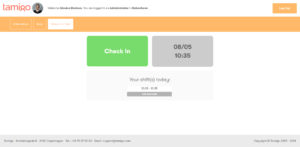Have you already heard about the different methods that exist to control the time register? Do you know what techniques are used in the retail sector? We will tell you about it below!
What is the Time Registration law about?
As you may know, the rules of the game have changed since May in Spain. A new law has been enacted on clocking and time registration. Similar laws already exist in other countries in Europe, such as Germany, France, Italy or the Netherlands. But, for the last couple of months for the first time, companies have been required to have control over the working hours of their workers in Spain. Thank to this new law, both parties comply with the obligations and rights established in the contract. This is why workers have to register at the beginning and the end of their shifts.
4 Methods for Implementing Time Registration
Manual method:
Some companies prefer a traditional method, in which they put a sheet with a grid in which the employee must enter into the template their information and mark the entry and exit times of all their shifts. They usually use programs such as Excel to generate these templates. This system is very widespread in the retail sector, especially considering the casuistry of split schedules.

Verification
With this method, a predefined weekly schedule is presented. Once the week has passed, the employee must check whether the hours indicated correspond to those worked. When they do not match, he must correct them and if they are correct, he must simply sign them. This is the most widespread system in retail. In this sector, schedules are usually set by weeks and retailers are warned a week in advance or several. As they are predefined schedules, it would be enough for the worker to check that everything is in order once the week is over.
Card
The card method is one of the most used in different sectors, especially in large companies, both in the office and in the retail sector. Each employee has a card that is registered in the system with their data.The employees must swipe their card through a machine.
New methods of time registration in the digital environment
In the digital environment, we have several options, ranging from the use of an app to a website. Sometimes it can even be a software implemented on a computer. Some programs recognized for their efficiency are Bixpe, Tamigo, and Sesame Time. For example, with Tamigo, the employee enters their user and then clicks them in and out. The employee must access with their number and manually clock in; either by hitting a button or using their fingerprint or password. In digital signatures, managers or bosses are the only ones with access to make changes in case of mistakes.
A positive aspect of some transfers with apps is that in some cases have geolocation and automatically sign the employee when he enters and leaves the default location. A negative aspect is that in some programs it round the hours instead of being precise; for example, if the employee chips at 8:13, it will be rounded as if he had entered at 8:15.

But it’s just the beginning of so many other possible transfer methods in companies! Little by little, thanks to technological innovations, these processes will become easier for employees as well as for companies. We must understand that this law is to protect and shield the employment contracts established with employees and for companies to have control of the hours worked which will reduce economic losses and increase efficiency when working.
Written by Clarissa Larrain
